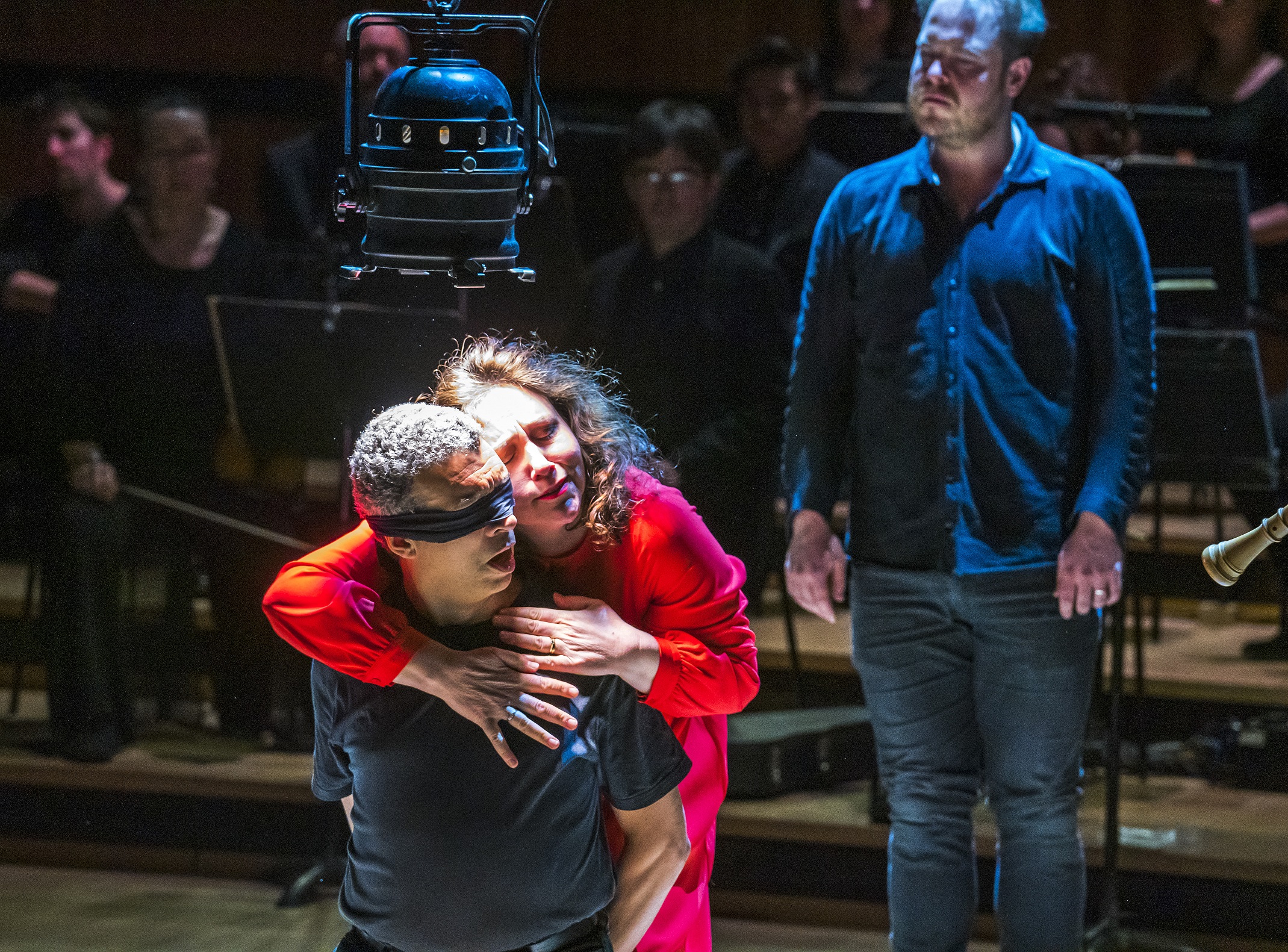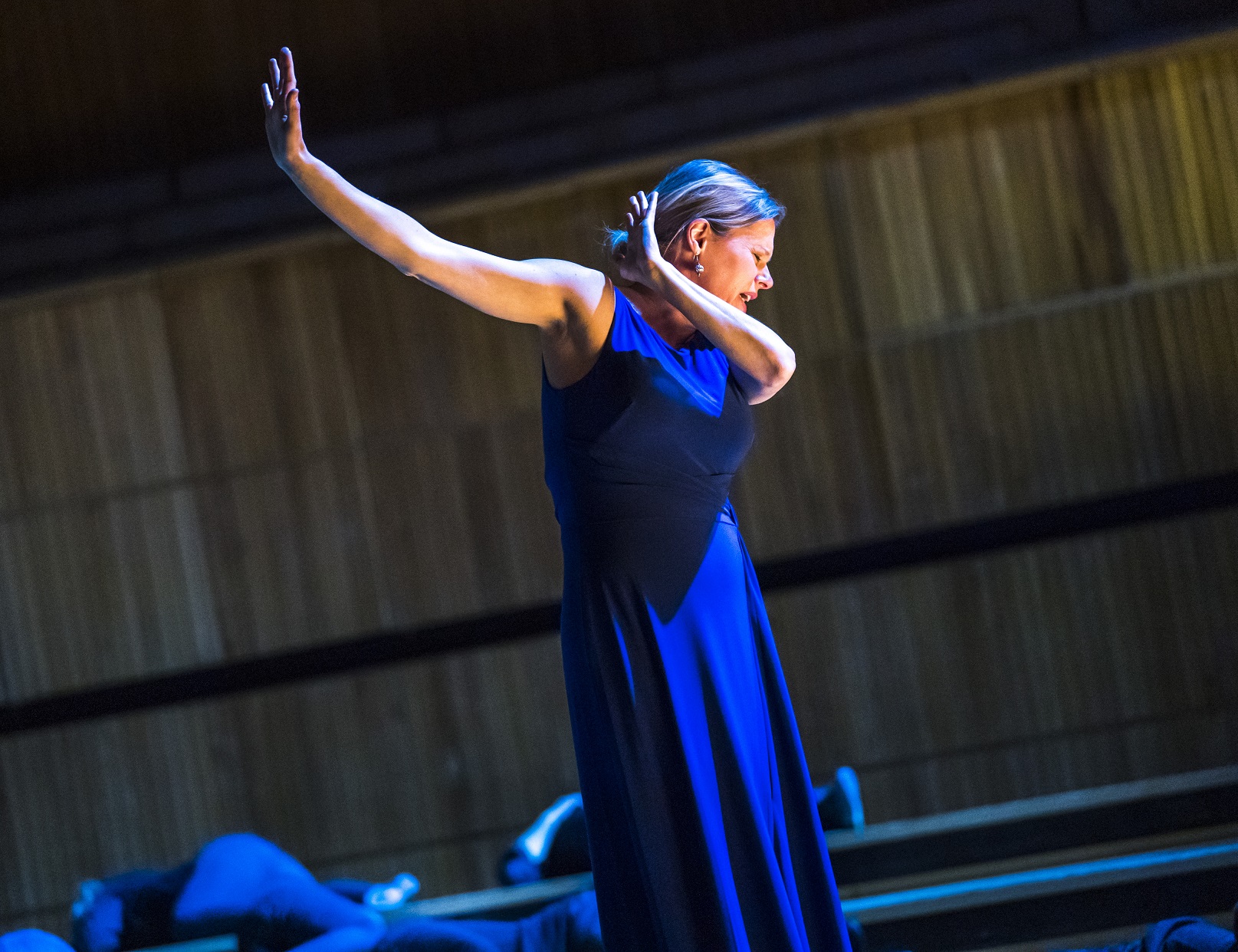Bach St John Passion, OAE, Rattle, RFH review – earnest devotions | reviews, news & interviews
Bach St John Passion, OAE, Rattle, RFH review – earnest devotions
Bach St John Passion, OAE, Rattle, RFH review – earnest devotions
Peter Sellars presents Bach for 2019 in a ritual without religion

We live in a secular age, or so we’re told. Yet we seem to need rituals, the age-old practice and province of religion, as much as ever.
"It’s not theatre. It’s a prayer," says Sellars. In truth we experience both, and neither, at his godless touring Oberammergau. The first chorus depicts a tableau of souls in limbo, singers prostrate, pleading for relief and redemption with gestures drawn from medieval iconography. With the strings of the Orchestra of the Age of Enlightenment tucked away in a back corner of the Royal Festival Hall stage, much inner-part counterpoint went for very little, smoothed away by Rattle into a backdrop for the sinuous legato of the oboes’ overlapping lamentations. An interrogation lamp hangs centre-stage and it is to this that Roderick Williams’ Christus (pictured above with Christine Rice's penitent Magdalen) is led as a prisoner, an everyman stripped of dignity like almost all everyone else on stage by more or less ill-fitting, studiously uncostumed black shirts and slacks – you could confuse most of them for the technical crew running the show until they open their mouths. With simple, naturalistic and discreetly updated imagery the story of Christ’s arrest and execution is told by singers who mine every syllable for beauty and meaning – none more so than Mark Padmore, whose careworn Evangelist has been refined over the years as if by a monk-scribe labouring over every last detail of the illuminated manuscript before him.
An interrogation lamp hangs centre-stage and it is to this that Roderick Williams’ Christus (pictured above with Christine Rice's penitent Magdalen) is led as a prisoner, an everyman stripped of dignity like almost all everyone else on stage by more or less ill-fitting, studiously uncostumed black shirts and slacks – you could confuse most of them for the technical crew running the show until they open their mouths. With simple, naturalistic and discreetly updated imagery the story of Christ’s arrest and execution is told by singers who mine every syllable for beauty and meaning – none more so than Mark Padmore, whose careworn Evangelist has been refined over the years as if by a monk-scribe labouring over every last detail of the illuminated manuscript before him.
Sometimes the narrative really does hang by a thread. You could hear Pinter whistling from the other side in the pause after Pilate’s rhetorical enquiry, "What is truth?" There is a tension never satisfactorily resolved by Rattle and Sellars between the sophistication of what we hear and, at a lower level, what we see. Moments such as the bickering over Christ’s robe match text, music and movement to revelatory effect but the heart sinks when chorus members mime picking up a grain of sand to a line from a chorale, or when Williams must deliver his last lines with his face pressed into the Festival Hall stage. A sumptuous continuo section was led by Steven Devine’s punchy organ contribution and Luise Buchberger’s beautifully drawn cello lines, coloured in by lute and contrabassoon. Georg Nigl, Andrew Staples, Christine Rice and Camilla Tilling all excelled in their arias – Tilling’s lament of deposition over the body of Christ was nigh-flawless (pictured above) – and Rattle directed proceedings with polished and choreographed assurance, though what his movements added to the chamber-music making between five or six musicians in the arias wasn’t always evident. In all its earnest compassion, its technical confidence and reach across history, this is very much a Passion of our time.
A sumptuous continuo section was led by Steven Devine’s punchy organ contribution and Luise Buchberger’s beautifully drawn cello lines, coloured in by lute and contrabassoon. Georg Nigl, Andrew Staples, Christine Rice and Camilla Tilling all excelled in their arias – Tilling’s lament of deposition over the body of Christ was nigh-flawless (pictured above) – and Rattle directed proceedings with polished and choreographed assurance, though what his movements added to the chamber-music making between five or six musicians in the arias wasn’t always evident. In all its earnest compassion, its technical confidence and reach across history, this is very much a Passion of our time.
rating
Explore topics
Share this article
The future of Arts Journalism
You can stop theartsdesk.com closing!
We urgently need financing to survive. Our fundraising drive has thus far raised £49,000 but we need to reach £100,000 or we will be forced to close. Please contribute here: https://gofund.me/c3f6033d
And if you can forward this information to anyone who might assist, we’d be grateful.

Subscribe to theartsdesk.com
Thank you for continuing to read our work on theartsdesk.com. For unlimited access to every article in its entirety, including our archive of more than 15,000 pieces, we're asking for £5 per month or £40 per year. We feel it's a very good deal, and hope you do too.
To take a subscription now simply click here.
And if you're looking for that extra gift for a friend or family member, why not treat them to a theartsdesk.com gift subscription?
more Classical music
 Jakub Hrůša and Friends in Concert, Royal Opera review - fleshcreep in two uneven halves
Bartók kept short, and a sprawling Dvořák choral ballad done as well as it could be
Jakub Hrůša and Friends in Concert, Royal Opera review - fleshcreep in two uneven halves
Bartók kept short, and a sprawling Dvořák choral ballad done as well as it could be
 Monteverdi Choir, ORR, Heras-Casado, St Martin-in-the-Fields review - flames of joy and sorrow
First-rate soloists, choir and orchestra unite in a blazing Mozart Requiem
Monteverdi Choir, ORR, Heras-Casado, St Martin-in-the-Fields review - flames of joy and sorrow
First-rate soloists, choir and orchestra unite in a blazing Mozart Requiem
 Cho, LSO, Pappano, Barbican review - finely-focused stormy weather
Chameleonic Seong-Jin Cho is a match for the fine-tuning of the LSO’s Chief Conductor
Cho, LSO, Pappano, Barbican review - finely-focused stormy weather
Chameleonic Seong-Jin Cho is a match for the fine-tuning of the LSO’s Chief Conductor
 Classical CDs: Shrouds, silhouettes and superstition
Cello concertos, choral collections and a stunning tribute to a contemporary giant
Classical CDs: Shrouds, silhouettes and superstition
Cello concertos, choral collections and a stunning tribute to a contemporary giant
 Appl, Levickis, Wigmore Hall review - fun to the fore in cabaret and show songs
A relaxed evening of light-hearted fare, with the accordion offering unusual colours
Appl, Levickis, Wigmore Hall review - fun to the fore in cabaret and show songs
A relaxed evening of light-hearted fare, with the accordion offering unusual colours
 Lammermuir Festival 2025, Part 2 review - from the soaringly sublime to the zoologically ridiculous
Bigger than ever, and the quality remains astonishingly high
Lammermuir Festival 2025, Part 2 review - from the soaringly sublime to the zoologically ridiculous
Bigger than ever, and the quality remains astonishingly high
 BBC Proms: Ehnes, Sinfonia of London, Wilson review - aspects of love
Sensuous Ravel, and bittersweet Bernstein, on an amorous evening
BBC Proms: Ehnes, Sinfonia of London, Wilson review - aspects of love
Sensuous Ravel, and bittersweet Bernstein, on an amorous evening
 Presteigne Festival 2025 review - new music is centre stage in the Welsh Marches
Music by 30 living composers, with Eleanor Alberga topping the bill
Presteigne Festival 2025 review - new music is centre stage in the Welsh Marches
Music by 30 living composers, with Eleanor Alberga topping the bill
 Lammermuir Festival 2025 review - music with soul from the heart of East Lothian
Baroque splendour, and chamber-ensemble drama, amid history-haunted lands
Lammermuir Festival 2025 review - music with soul from the heart of East Lothian
Baroque splendour, and chamber-ensemble drama, amid history-haunted lands
 BBC Proms: Steinbacher, RPO, Petrenko / Sternath, BBCSO, Oramo review - double-bill mixed bag
Young pianist shines in Grieg but Bliss’s portentous cantata disappoints
BBC Proms: Steinbacher, RPO, Petrenko / Sternath, BBCSO, Oramo review - double-bill mixed bag
Young pianist shines in Grieg but Bliss’s portentous cantata disappoints
 theartsdesk at the Lahti Sibelius Festival - early epics by the Finnish master in context
Finnish heroes meet their Austro-German counterparts in breathtaking interpretations
theartsdesk at the Lahti Sibelius Festival - early epics by the Finnish master in context
Finnish heroes meet their Austro-German counterparts in breathtaking interpretations
 Classical CDs: Sleigh rides, pancakes and cigars
Two big boxes, plus new music for brass and a pair of clarinet concertos
Classical CDs: Sleigh rides, pancakes and cigars
Two big boxes, plus new music for brass and a pair of clarinet concertos

Add comment